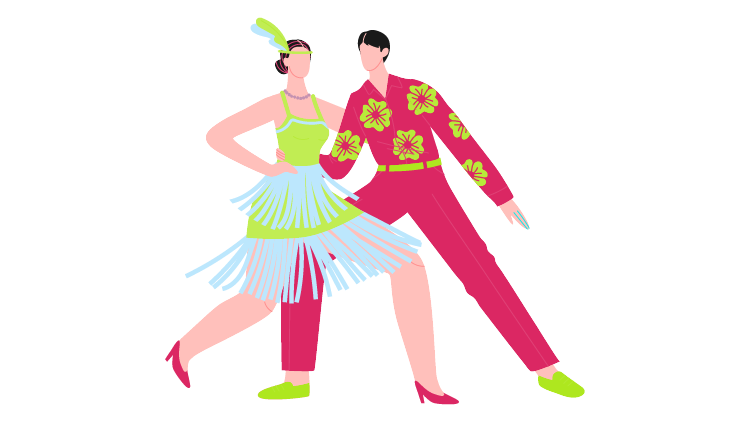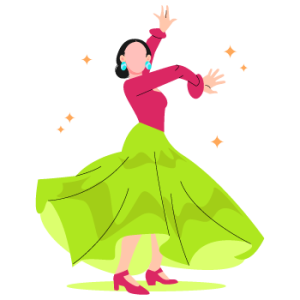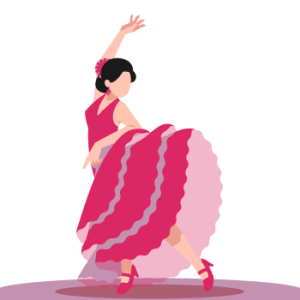
The Intriguing Rhythm of Spanish Latin Dances
Spanish Latin Dances are a captivating and vibrant form of expression that encompasses a wide range of dance styles originating from Spain and Latin America. These dances are not only a source of entertainment but also a reflection of the rich cultural heritage and traditions of the Spanish-speaking world. From the fiery passion of Flamenco to the sultry moves of the Tango, each dance tells a unique story through its rhythm and movements. Join me on a journey as we unravel the mesmerizing world of Spanish Latin Dances.
Unraveling the Roots of Spanish Latin Dance
Exploring the genesis of Spanish Latin Dance takes us on a historical journey through the diverse landscapes of Spain and Latin America. Originating from a tapestry of cultural influences, these dance forms are a testament to the intricate blend of Spain’s traditional dances with the indigenous, African, and other European elements found in the Americas. Flamenco, with its deep roots in Andalusia, serves as a prime example of this cultural fusion, where Gypsy, Moorish, and even Sephardic Jewish influences converge to create a dance of profound emotional depth and technical complexity. As Spanish Latin Dances traversed the Atlantic, they absorbed and adapted to the rhythms and movements of Latin American countries, giving birth to a myriad of styles each with its distinct flavor yet sharing a common heritage. This evolution reflects the dynamic history of Spanish-speaking peoples, illustrating how dance can serve as a living record of societal change, migration, and cultural exchange. The development of these dances is not merely a historical footnote but a vibrant narrative of resilience, adaptation, and creativity, highlighting the rich cultural tapestry that defines the Spanish Latin Dance tradition.

The Fiery Flamenco: Passion and Precision
Flamenco stands as a magnificent representation of Spanish Latin Dances, celebrated for its intense emotional depth and meticulous technique. This dance, with its origins steeped in the heart of Andalusia, embodies a powerful blend of cultural influences that have shaped its unique character. Flamenco’s essence lies in the profound expression of a wide spectrum of emotions, with dancers conveying stories of joy, despair, love, and loss through their movements. The dance demands a high level of technical skill, with precise footwork, intricate hand and arm movements, and controlled body gestures that require years of dedicated practice to master. The performance space becomes a stage for an electrifying display of artistry, as the dancer’s rapid foot stomps echo with compelling rhythm, and their hands carve the air with grace. Flamenco costumes add another layer of allure, with vibrant colors and flowing fabrics that accentuate every movement. The dance’s dramatic intensity is further heightened by the cante (singing), toque (guitar playing), and palmas (handclaps), creating an immersive experience that captivates the audience. Flamenco is more than just a dance; it is a celebration of life’s emotions, a showcase of technical prowess, and a cherished cultural legacy that continues to resonate with passion and precision.
Salsa: The Melting Pot of Latin Rhythms
Salsa embodies the essence of Spanish Latin dances, captivating hearts with its energetic beats and fluid movements. Originating in the vibrant streets of the Caribbean, it represents a rich amalgamation of rhythmic influences, primarily drawing from the Cuban Son and the Puerto Rican Bomba, with a sprinkle of Afro-Caribbean dance elements. Its pulsating rhythm invites dancers to the floor, encouraging a spontaneous showcase of creativity and style. The essence of Salsa lies in its adaptability and the personal flair dancers bring, making no two performances alike. It’s a social dance at its core, emphasizing the connection between partners as they navigate the dance floor in a harmonious blend of steps and spins. The music, a lively concoction of percussion, brass, and strings, sets the pace for the dancers, whose steps and movements respond to its call and answer. Salsa is more than a dance; it’s a communal celebration, a space where individuals from diverse backgrounds converge to share in the joy of movement. As it continues to evolve, incorporating new styles and influences, Salsa remains a vibrant, dynamic force in the world of Spanish Latin dances, celebrated for its ability to bring people together in a spirited expression of cultural unity and joy. Know more about latin dance types.

Bachata and Merengue: The Dominican Heartbeat
Delving into the pulsating heart of the Dominican Republic, Bachata and Merengue stand out as quintessential embodiments of the nation’s spirited culture. Bachata, with its soulful melodies and tender lyrics, pairs with intimate partner connections, offering a dance experience rich in emotion and sensuality. The dance’s signature hip sways and step-tap movements convey stories of love, heartache, and joy, inviting dancers to portray genuine feelings with each glide across the floor. Conversely, Merengue propels dancers into an upbeat tempo, characterized by its lively rhythm and simplistic step pattern. This dance encourages a festive atmosphere, where participants can enjoy the freedom of movement in a more relaxed, joyful environment. Both styles emphasize the beauty of natural movement, allowing dancers of all skill levels to participate and find their rhythm within the music’s embrace. As cultural hallmarks, Bachata and Merengue represent more than just dance forms; they are vibrant expressions of Dominican life, encapsulating the essence of its people’s warmth, resilience, and communal spirit. These dances serve as a bridge, connecting generations and fostering a sense of identity and pride among Dominicans, both at home and abroad. Through the universal language of dance, Bachata and Merengue continue to enchant and inspire, inviting everyone to experience the rhythmic heartbeat of the Dominican Republic.
The Tango: A Dance of Emotion and Elegance
Originating in the vibrant neighborhoods of Buenos Aires, the Tango is as much a story told through movement as it is a dance. It thrives on the intimate, intricate interplay between partners, where every step and pause communicates a narrative of longing, passion, and intricate emotions. This dance is characterized by its dramatic flair, featuring close embraces, precise footwork, and fluid movements that glide across the dance floor. The Tango requires a deep understanding between partners, as they navigate its complex steps and rhythms in a harmonious and seemingly effortless display of elegance. The music that accompanies the Tango is equally evocative, with its melancholic melodies and rhythmic pulses setting the stage for a performance that is both captivating and profoundly moving. Beyond its technical aspects, the Tango is a reflection of the human condition, exploring themes of connection, desire, and the complexity of relationships through its expressive choreography. It stands as a poignant emblem of Argentine culture, revered for its ability to convey deep emotional landscapes through the art of dance.
Exploring Other Spanish Latin Dances
The vast landscape of Spanish Latin dances offers a rich tapestry of rhythms and styles, each with its distinct heritage and allure. Venturing beyond the well-known Flamenco, Salsa, Bachata, Merengue, and Tango reveals a world teeming with vibrant dance forms like the Cumbia and Rumba. Cumbia, originating from Colombia, captivates with its rhythmic fusion of Indigenous, African, and Spanish influences, inviting dancers into a celebratory, communal dance experience. The dance floor becomes alive with the circular movements and festive spirit that Cumbia brings. On the other hand, Rumba, with its roots deeply embedded in Cuban culture, entices with its slow, sensual rhythms and intricate hip movements, offering a dance that is both an art form and a narrative of everyday life. Each dance, from the energetic leaps of Mambo to the flirtatious nuances of Cha-Cha, presents a unique opportunity to immerse oneself in the diverse and dynamic world of Spanish Latin dances. These styles not only enrich the global dance scene but also serve as cultural ambassadors, sharing the stories, emotions, and traditions of their respective communities. Engaging with these dances opens up new avenues of cultural exploration and appreciation, inviting dancers and enthusiasts alike to broaden their horizons within the mesmerizing realm of Spanish Latin dances.
The Cultural Significance of Spanish Latin Dances Today
In the contemporary landscape, Spanish Latin Dances resonate as powerful symbols of community and cultural pride. Across the globe, these dances are celebrated, bridging gaps between generations and geographical divides. They enrich community gatherings, light up competitive stages, and are the heartbeat of many cultural festivals, offering a dynamic platform for showcasing diverse talents. These dance forms facilitate a unique form of communication, where stories, emotions, and cultural values are shared and understood beyond the confines of language. They foster a sense of belonging and connection among individuals, allowing for the preservation and continuation of cultural traditions in an increasingly globalized world. As dynamic expressions of cultural identity, Spanish Latin Dances play a crucial role in maintaining the vibrancy and richness of Spanish and Latin American cultures, engaging audiences and participants in an ongoing dialogue of tradition, innovation, and communal celebration. Through these dances, the spirit of shared humanity and cultural heritage flourishes, underscoring the universal language of dance as a uniting force.
Frequently Asked Questions
What are "Spanish Latin Dances"?
“Spanish Latin Dances” encompass a variety of dance styles originating from Spain and Latin American countries, known for their vibrant rhythms and expressive movements.
What are some popular types of Spanish Latin dances?
Popular types include Flamenco from Spain, Salsa from Cuba, Tango from Argentina, Merengue from the Dominican Republic, and Samba from Brazil.
What is unique about Flamenco dance?
Flamenco is characterized by its passionate and intense style, featuring intricate footwork, hand claps, and guitar music, reflecting the rich cultural heritage of Spain.
How is Salsa danced and where did it originate?
Salsa is a lively, energetic dance with fast footwork and spins, originating in Cuba, and is usually performed to upbeat Latin music.
Can beginners easily learn Spanish Latin dances?
Yes, many Spanish Latin dances are accessible to beginners, with numerous dance schools and online tutorials available to help new dancers learn the basic steps and techniques.

